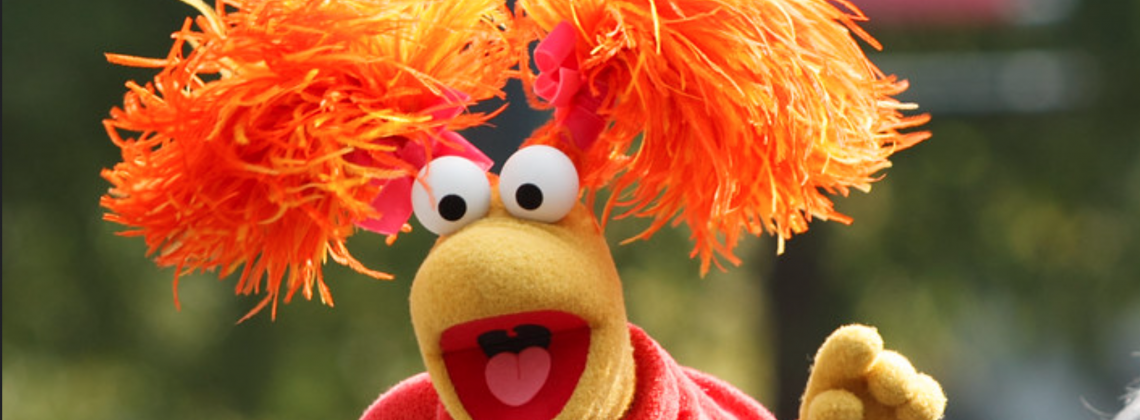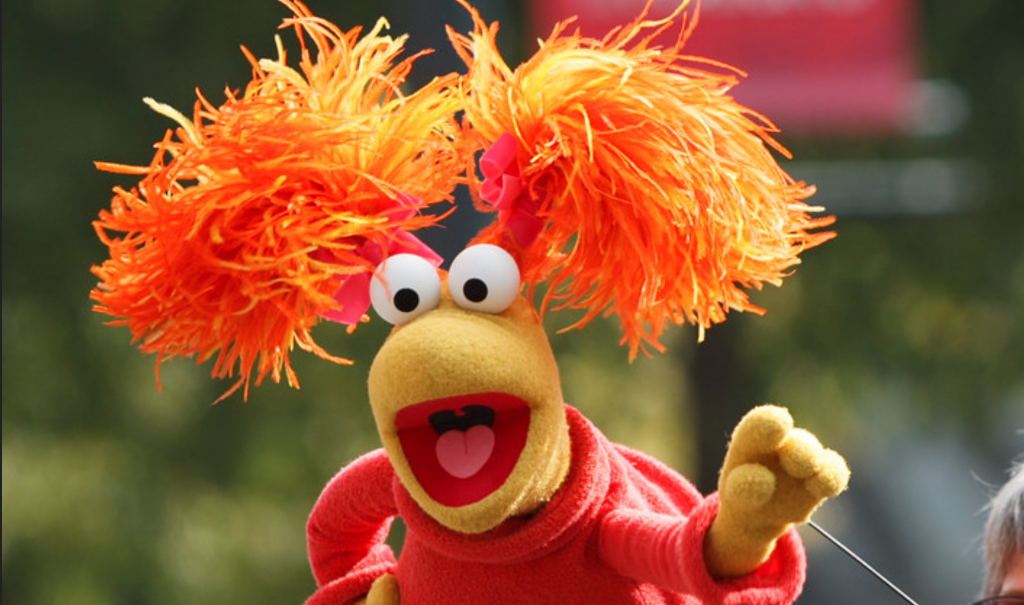

If the world is full of change, should our childhoods remain the same?
They changed Fraggle Rock.
The opening credits of the 1980s television series featured a merry chase between Gobo the Fraggle and the giant Junior Gorg. The Gorg grabs the Fraggle because Gorgs eat Fraggles, but then Mommy Gorg frightens Junior into dropping Gobo down the well to splash harmlessly in a Fraggle lagoon. The 2022 reboot, however, nixes the violence and intimations of puppet cannibalism. Instead, Junior Gorg pulls a radish from the earth, which he bobbles and drops down the well to the Fraggles.
(Did I mention that Fraggles are tiny, loveable puppet creatures? I meant to.)
There were other changes too. The show’s lone human character, Doc, was originally portrayed as a crusty old Canadian from the Maritimes by veteran actor Gerard Parkes. 2022’s Doc is now played by a young Black actress (and Tony nominee) Lilli Cooper. Margery the living trash heap lost her New York Jewish accent. And a major plot thread in the first season has to do with disruptions to the water supply on which Fraggles, Gorgs, and humans rely.
In short, Fraggle Rock is less violent and more diverse than it was thirty years ago. It would seem like a high-level target for a wokeness-antiwokeness struggle. But before I blame anyone, let me confess that I myself felt an internal twinge about what “they” did to “my” show: Hey, wait a minute! Junior Gorg is supposed grab GOBO and drop him! And then Gobo says “Whooppee!”
(Note: if you think this small detail is too trivial to obsess over, then you have never had an argument about whether Spider-Man’s web fluid should be natural or manufactured.)
But so far as I can tell, no major public figures are raging about wokeness in Fraggle Rock. Random internet commentary is, of course, raging about it, but as of this writing it hasn’t yet achieved prominence. So Fraggle Rock is a good place to think about that twinge of mine. Why did they CHANGE that? What are they trying to teach my kids?
In one sense, reboots are a reminder that time is happening. Change happens to make the plot work. The thieves in Ocean’s 11 (1960) knew each other from serving in the same World War II unit; that was hardly an option for Ocean’s Eleven (2001). The Manchurian Candidate in 1962 came from China; in 2004 he came from the Manchurian Corporation. Facial recognition technology makes most of the Sean Connery Bond films even less plausible than they already are.
But sometimes the changes seem more related to mood than to tech. In 1948, Bill Finger created The Riddler as a guy who really liked puzzles; in The Batman (2022), the Riddler is a serial killer. (Comedian Griffin McElroy noted that “Riddler” isn’t really accurate for the new version because “if you murder a lot of people and ask some riddles here and there, they should call you The Murderer.”)
So it’s not a question of what changed but whether the changes were good. (Gus Van Sant attempted an exact shot-by-shot remake of Hitchcock’s Psycho in 1998. No one saw it.) In other words, can a creative team make something new with an existing property? Or is it enough to simply repeat the past?
Here is the connection to wokeness—which, despite its excesses, is about recognizing that maybe the past isn’t a fairy tale or an amusement park. Slavery really did dominate early America. Law really did discriminate between people of different races. American armies really did seize Indian land by force and redistribute it to white Americans at low or no cost. (See the Homestead Act.) The past pushes in on the present, and some folks are trying to recognize that. Whether rewriting or recrafting fictional stories helps ameliorate those facts is a separate question.
Yet much of the anti-wokeness debate ignores the difference. Any deviation from the original—especially regarding race—is considered wrong in and of itself. People complained when Michael B. Jordan (who is Black) was cast as The Human Torch (who was created as white by Stan Lee) in the 2015 film Fantastic Four. People complained when Anna Diop (born in Senegal) was cast as Starfire in the TV version of Titans, while the original Starfire created by Marv Wolfman and George Perez was . . . orange.
I really, really don’t want to associate my Fraggle Rock twinge with the effort to insist that superheroes have to be white if they were created as white in the 1960s. I do want to talk about anti-wokeness and that feeling of resentment that ran across my brain: This isn’t what I remember from my childhood.
And yes: It isn’t. When the great properties of the 1960s and 70s made their way into Gen-X brains like mine, TV, comics, and film were producing a certain kind of television aimed at primarily white audiences and projecting a folksy everything’s-okay image. On October 25, 1962, as American and Soviet armies were preparing for the Cuban Missile Crisis to turn into a full-blown nuclear war, Leave it to Beaver aired an episode in which Wally tries to get the Beav to help him babysit. When Rod Serling tried to write a TV drama about the Emmett Till lynching the censors cut it to pieces. In 1974, Marvel introduced a Black supervillain named “Black Talon” who was (a) Black, (b) practiced voodoo, and (c) had both an upside-down cross and a chicken head incorporated into his costume. He has yet to make it into the Marvel Cinematic Universe.
The point is, what we saw reflected on TV and in comics wasn’t “real.” Just like Fraggles aren’t real. So being fictional, they can change. And being fictional, they can stay the same.
The politics and culture of nostalgia are complicated. But part of it boils down to wanting our stories to stay the same and so give us an anchor in rough times. It’s the same way we get nostalgic for the 1980s by thinking about Mr. T and Top Gun and leave out nuclear drills, AIDS, and crack cocaine.
Fictional properties can change or not change. The question is whether the new versions give us something in 2022 that is better than what we would get from the rose-tinted nostalgia of the originals.
Are the changes in Fraggle Rock worth it? Yeah, I think so. Junior Gorg is a loveable character, and he’s no longer bossed around by his parents. Also, he finally gets a real friend, who is a tree. (It’s puppets, people.) Lilli Cooper plays a real character with real fears about the future of the oceans. And even though I loved the Trash Heap because she sounded like my bubbe, a Jewish Trash Heap is maybe not something we really need.
And the Fraggles are still the same. They’re puppets. And they’re still struggling along, making good-hearted mistakes and trying to figure out the world. If their problems are a bit updated—in one episode, a Fraggle follows her feelings rather than a factual map and ends up in a literal Echo Chamber—well, that’s what a reboot should do: bring old ideas back to look at new problems. If you don’t like it, watch the original. (The 1959 Ben-Hur is far superior to the 2016 version.)
Nostalgia is strong in days of war and pandemics. But we’re kidding ourselves if we think the fiction of the past and its all-white heroes with simplified issues was an accurate reflection of America, or of the problems of the time. Those fictions were also . . . fictions. The question is not whether any change has happened, but whether the change was good.
After all, Jason Mamoa’s 2018 Aquaman was a significant upgrade from the goofy water-breathing white guy from More Fun Comics in 1941. Some things get better with age. Including Fraggles.
Adam Jortner is the Goodwin-Philpott Professor of Religion in the History Department at Auburn University. He is the author of the Audible series Faith of the Founding Fathers and was part of the creative team behind Where in Time is Carmen Sandiego?